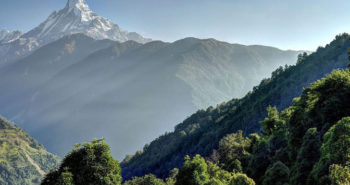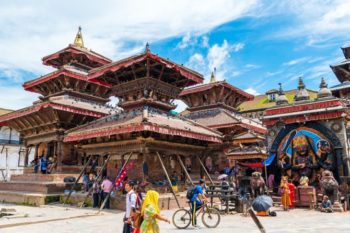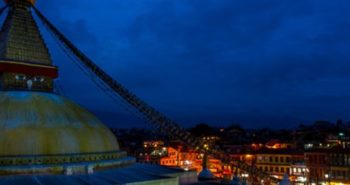Everest Base Camp Trek in September
This marvellous trek has been popular for decades for good reason. The mountain views, particularly of Mount Everest, the landscapes, and the Sherpa people make for an interesting way to pass a couple of weeks while stretching your body to its limit.
Being a strenuous trek, it may not be for everyone. But those who do come for the EBC Trek all agree it is well worth the effort.
Preparation before coming to Nepal is essential so that you are at the best fitness level you can be. Your gear should also be the best you can get because that makes all the difference between a good trek and a great trek.
This is a high altitude trek and preparation for this is not as easy as preparing your legs for a lot of walking! If you can hike up high hills in your home area then so much the better. But with acclimatization days built into the itinerary, the majority of people do not have much trouble adapting to the low levels of oxygen in the air.
Overview of Trekking to EBC in September
September is the tail-end of the monsoon season in Nepal. As there is less rainfall anyway in the mountains than in the hills and lowlands, you are not likely to encounter too much rain in September. There still may be clouds covering the mountains and causing flight delays. The average temperatures in Namche Bazaar in September are around 15oC (59oF). At night it is likely to fall to around 6oC. Not too cold for this location.
There will still be the chance of slippery trails due to rain and perhaps some landslides still in place from earlier in the monsoon. You should ask at each lodge if they have news of any tricky areas.
It is still pretty much ‘off-season’ for trekkers but by the end of the month, you will see more people on the trails.
Weather and Climate in September in the Everest Region
Some rain may take place and the mountains may still be covered in clouds at the start of the month. It will not be cold, except when it rains.
Pros and Cons of Trekking to EBC in September
There is still the possibility of flight delays caused by monsoon weather outside of the Everest Region, and the road between the airport at Ramechhap and Kathmandu may have landslides on it.
Good waterproof trekking boots are still required as are a rain jacket and waterproof coverings for your bags.
Overall, by the end of September the skies will be clearer and the land drier but do bring some waterproofs just in case.
Preparing for the Everest Base Camp Trek in September
Physical Fitness and Training
Preparation for trekking in the Himalayas is a must. Up your regular fitness routine and add hiking to it if possible. Cardio and hiking up and down hills will help immensely.
Acclimatization and Altitude Sickness
Almost everyone needs to acclimatize when they reach the Everest Region. The EBC Trek has acclimatization built into the itinerary – at Namche Bazaar and at Dingboche. These acclimatization days ensure that your body is in the best possible condition to go further up the trails to where the air is thinner.
It is important not to miss these acclimatization days, even if you feel you are fit and well. This may be particularly tempting if you are travelling solo. But it is more important to stay healthy than to race around the trekking route.
If you feel unwell, headache, or nausea, unable to sleep, please tell your guide. If your headache does not go away, you should go down in altitude. Travelling too fast will only lead to more problems, so pace yourself. You are here to enjoy the beauty of the mountains after all.
If you are worried about your health, you can check the health posts on the trail. They will advise you whether they think you are fine to continue, or whether you should go down in altitude or even give up your trek altogether for this year.
Tips to Avoid Altitude-Related Illness
- Drink a lot of water to stay hydrated. No alcohol please as this will dehydrate you further.
- Eat well – it is important to eat three times a day to keep your energy levels up. You will burn so much more fuel on the trek than at home.
- Take your time – it is not a race. Pay attention to the itinerary for the EBC Trek –it’s made that way for a reason: to ensure everyone stays healthy and enjoys their adventure.
- If you have a headache keep a note of how, if, it progresses in case it is serious. Combined with being unable to sleep, or eat, a headache can be the first sign of a serious altitude illness.
- If you feel or are told you have altitude sickness, never go higher, always go lower.
- Altitude sickness can happen to anyone, regardless of age or overall fitness.
Essential Gear and Clothing for Everest Base Camp Trek in September
Here is an all-season list of gear for trekking to EBC. You need to carry waterproofs this month as it is the end of the monsoon.
- Sleeping bag and inner sleeping bag
- Trekking boots. Waterproof with a good gripping sole.
- Trekking trousers as standard and waterproof over trousers for the days it might rain.
- Trekking tops or shirts.
- Fleece jacket and a waterproof jacket.
- Gloves and a warm hat for evenings
- Sun hat for during the day. The waterproof hat is also a good idea.
- Trekking poles
- Moleskin for blisters
- Waterproof cover for the daypack
- Dry bags for dirty clothes etc.
- Nepali rupees for hot water for showers, charging your equipment and buying soft drinks etc. If you are going solo, Nepali rupees for accommodation and meals too.
- Sunscreen
- Lip balm
- Moisturiser
- Water bottle
- Water purifying tablets or purifying straws for drinking water
- Sunglasses: high altitude sunlight is strong
- Camera and waterproof case/ bag
- Whistle (in case of emergencies)
- Medical kit (including extras of your regular medicines in case of delays)
- Personal hygiene kit: toothpaste, toothbrush, shampoo, soap, sponge, towel, toilet paper
- Washing soap for clothes if you really must wash something
- Notebook and pen for journaling
- Phone charger and power pack
Obtaining Permits and Documentation for EBC Trek
You need two main permits to trek in the Everest Region:
Khumbu Pasang Lhamu Rural Municipality Entrance Permit: Nrs 2,000 per person.
Obtainable in Lukla or Monjo. Not available in Kathmandu.
Sagarmatha National Park Entry Permit: Nrs 3,000 per person
The parking permit is obtainable at the Nepal Tourism Board Office in Kathmandu or in Monjo at the entrance gate for Sagarmatha National Park. It is more convenient to purchase this at Monjo.
Gaurishankar Conservation Area Permit is required if you are trekking in from Jiri at NPR 3,000 per person. This is obtainable at the Nepal Tourism Board in Kathmandu.
Required documents for trekking permits: you need a copy of your passport for all permits. For the Gaurishankar Conservation Area Permit, you will also need to provide two passport-sized photographs. Pay in local currency.
Itineraries and Routes
Popular Route Options in September
All routes are open in September. Just check if there are known landslides on any of the trail sections.
Trekking with Helicopter Tour in September
Our 5, 6, 7, 8, or 9-day treks to EBC and return to Kathmandu by helicopter are a great way to do part of this trek and then fly back via helicopter. Much less hard on the body, and surprisingly easy on the wallet.
This is perfect for the end of the monsoon when there may still be more strenuous days due to rain and slippery rocks, etc.
Modifications Due to Weather Conditions
Flight delays can still happen in September when the lower parts of the country are still in the monsoon. Bear this in mind when making your onward plans.
All trails will be open in the Everest Region unless there are any landslides not cleared yet.
Major Stops and Highlights Along the Way
EBC Trek is famous for the mountains you see on the way and the people you will meet – from the local Sherpa communities to other trekkers and mountaineers. Some of the highlights of this trek are as follows:
Flying into Lukla. Named after the first summiteers, the Hillary Tenzing Airport is one of the highest in the world. It is a thrilling experience to fly in and out here.
Trekking to Namche Bazaar gives you your first taste of what is to come.
Namche Bazaar is where you spend time acclimatising, giving you a great opportunity to explore the surrounding area.
Visit the Tenzing Norgay Sherpa Heritage Centre which only opened in May 2023.
Visit the Irish Pub in Namche for some Guinness and great conversation. Maybe some dancing too.
Check out the bars in Namche that offer movies about Everest every afternoon.
Find the best bakery in town for cakes and pastries.
Visit the Saturday market in Namche Bazaar to witness the locals doing their weekly shopping. Perhaps you will buy some handicrafts to take home.
Hike to Khumjung to find the school and health post-Edmund Hillary helped establish.
Go bird watching. Trying to spot Nepal’s national bird, the Danphe, is a unique thing to do in the mountains.
Hike to Hotel Everest View. Magnificent views and hot drinks on the terrace!
Stop in at Tengboche Monastery to meet Buddhist monks. Evening and morning pujas (religious ceremonies) take place daily and guests are welcome. And take a look at the wonderful mountain views from the monastery grounds. Note, it is usual to make a small donation to the Monastery.
Lobuche is a small, simple, but extremely important settlement at 4,940m/ 16,210 ft. It is the last settlement before Everest Base Camp.
Kalapattar is also known as Everest View Point. Can you think why?
Everest Base Camp – you have finally made it!
Major Highlight of the EBC Trek in September
There are no major festivals in the month of September around Everest. But just being there is like all your festivals rolled into one!
At lower altitudes, the forests and vegetation remain green after the monsoon. The mountains may still have some cloud cover, but this will give you fabulous, and unique photographs.
Other Highlights of Trekking to EBC in September Include:
• You can still enjoy sunrise and sunset from Kalapattar, regardless of the season.
• Exploring the Norgay Sherpa Heritage Centre in Namche is the latest thing to do in town.
• Explore Khumjung village and learn why Hillary thought so much of the Sherpas he opened a school here.
• Conversations with other trekkers over dinner or a cup of tea is what trekking is about.
• Prices for accommodation may still be negotiable before the start of the main season.
• Mount Everest – always a highlight!
Accommodation and Logistics in September
Teahouses and Lodges During the EBC Trek in September
In general, trekking lodges in Nepal – called teahouses – are simple affairs. Twin beds, shared bathrooms, cold showers, and hot food.
If you require a hot shower – and who wants a cold one in this climate – it will cost you around $3 a time. We find trekkers rarely take more than 2 or 3 showers on a trek.
If you have electronics to charge, the cost will be around the same for each piece of equipment. A power bank is a great investment for the trek.
Menus are pretty standard throughout the Everest Region. Good, filling, hot food ranging from curry to pasta, from Tibetan bread to porridge. It is customary to eat dinner and breakfast in the teahouse you sleep in.
Food and Water Availability in EBC Trek in September
As fridges are rare in this area, we suggest you do not eat meat on the trek. We also suggest you do not take water from the tap, or rivers, for drinking. If you do find a clean source of water, then add drops/ tablets to it. Otherwise, buy the boiled drinking water available in the teahouse.
Soft drinks and beer will also be available. Soft drinks somehow become so much more attractive on a trek, even if you don’t usually drink them. Please avoid alcohol as it will dehydrate you quickly.
Hiring a Guide and Porter for EBC Trek in September
The beginning of September is still pretty much off-season so it should be relatively easy to hire a porter or guide on arrival in Lukla. Towards the end of the month, many more trekkers will be arriving, and demand will be high.
If you are booking through a reputable agency, there will be no problem. If you are going solo be prepared to seek out a guide or a porter when you arrive in Lukla.
Safety and Travel Tips for EBC Trek in September
Monitoring Weather Conditions in September
There should be very little rainfall in September, but you should be prepared, with waterproofs, just in case. Also, be prepared for flight delays due to bad weather. Even if the sun is shining in the region, it may be cloudy and wet in the lowlands.
More out of interest, you can follow what is happening on Everest weather-wise through National Geographic’s own weather centre – the Everest Weather Station Network. For the weather at lower altitudes, you can put the setting for this station at its lowest (4,000m) https://everest-pwa.nationalgeographic.org/
Coping with the Weather and Altitude in September
Above you will find our tips for coping with altitude. Mainly it’s hydration and going slow.
For dealing with the weather, waterproof boots and a rain jacket are still recommended for this month. Waterproof coverings for day packs and electronics should also be carried.
Travel Insurance and Emergency Services in EBC Trek
Your insurance should cover you for trekking and trekking up to 5,000m. Make sure to read the small print! If you require to be evacuated by helicopter they will require proof of payment before coming.
For medical attention in Kathmandu, CIWEC Hospital in Lazimpat is well experienced in dealing with trekkers who suffer from stomach problems or altitude-related problems. They accept insurance and foreign currency.
There are health posts on the trials, but they will not accept insurance or foreign currency. Nepali cash only. Cards are also not accepted.
Health Posts Along the Trail
Carry a first aid kit with enough inside for simple cuts, bruises, and ailments. Your agency-booked guide should also have a first-aid kit with him.
For more serious ailments there are some health posts on the trails who can let you know whether they think it is safe for you to carry on or not.
Himalayan Sherpa Hospital, at Phakding, opened in November 2022 offering outpatient and emergency services to locals in its 15 beds. More information can be found here http://www.himalayansherpafoundation.org/project/himalayan-sherpa-hospital-in-phakding/
Himalayan Rescue Association (HRA), at Pheriche is manned during the busy spring and autumn trekking seasons by volunteer doctors – it may not be open in September depending on the weather situation. Operating since 1973, this is a non-profit organisation with the objective of reducing casualties in the mountains. They give a talk on altitude-related problems every day at 3 pm which you are welcome to attend. Donations are highly appreciated. More information is found here https://www.himalayanrescue.org/
The Mountain Medical Institute (MMI) clinic is found at Namche and Dingboche. Please note the Dingboche branch is closed in the winter months but will be open in peak trekking months. We are unsure about September, so call ahead. Staffed by doctors trained in the unique needs of people living and travelling at high altitudes, the clinic in Namche has a basic lab, EKG, and ultrasonography. Call: 985-2850021/ 981-3933179 / 984-1936205.
Be Responsible
Be prepared for all eventualities and be responsible for your own health and welfare, as much as you can be. Accidents do happen and those around will try to do what they can. But do not expect them to aid you financially – there are thousands of trekkers coming through annually!
Embracing the Challenges of Trekking in September
There may still be sections of slippery rocks and mud, perhaps even landslides. If there is rain, embrace it. Stay inside if it is heavy. Don’t be surprised if there are flight delays.
Tips for Trekking in September
• It will begin to get busy again with other trekkers towards the end of the month.
• Mountains may be cloudy at times.
• Good planning can benefit your trek immensely.
• Taking a guide or porter will make your trek more enjoyable and less stressful. Think carefully about this. You will also be helping local families make ends meet.
• Be particularly careful when walking over slippery rocks.
• Remember to leave time between your intended return to Kathmandu and your international flight, just in case!


